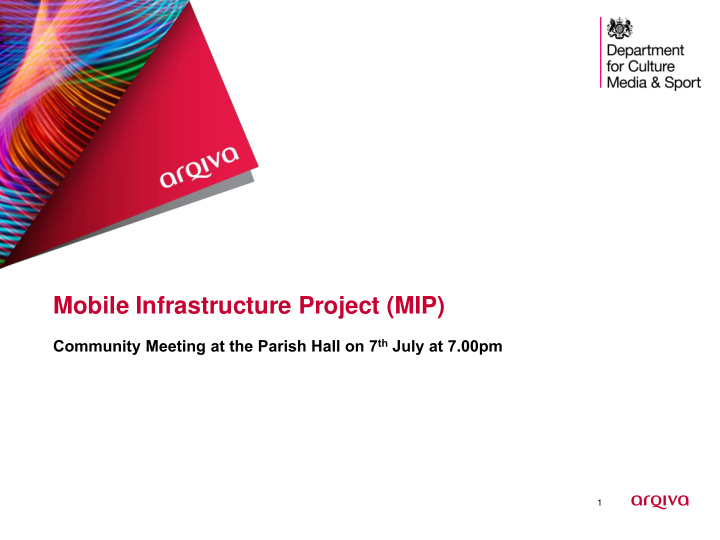



Mobile Infrastructure Project (MIP) 1
MIP - Overview A publicly funded project to provide mobile phone coverage by all four Mobile Network Operators (MNOs) in areas that have none at present ‘Not spots’ : Areas with no effective coverage by any of the mobile network operators, usually because it is uneconomic to do so An opportunity to be grasped - tackling market failure to provide mobile coverage to less populated areas State Aid funding means MIP cannot consider areas where there is coverage from at least one (UK) operator, but not from others State Aid funding is for improvements to “voice coverage and basic data”, but all sites will have the connectivity to manage upgraded services Operational & technical challenges – especially connecting the new sites into the MNOs’ networks 2
Those involved: The Department of Culture Media and Sport (Broadband Delivery UK) is meeting the capital cost of the project Arqiva has been contracted to deliver the project Harlequin are Arqiva’s acquisition agents The four Mobile Network Operators: • Have all agreed to provide a service from all MIP sites for 20 years • Have agreed to meet all the operating costs of doing so 3
The Challenge: - All on the same site! Planning permission Economic power supply (i.e. Nearby) Access for build and operation Economic site rental 4 Economic construction cost
Transmission Line of sight needed for connecting the site into the MNOs’ networks Every site needs TWO transmission links • One for O2 & Vodafone • One for EE and 3 The far ends of the links need capacity to carry the services back into the MNOs’ core networks MIP site Capacity for onward transmission 5
A Typical MIP Installation – 20 metres 6 (North Molton Devon)
In the wider context 7 (North Molton Devon)
In the wider context 8 (North Molton Devon)
Proposed installation of a 25m high telecommunications base station at Hensley Farm, East Worlington, Crediton, Devon EX17 4TG 9
Search Area- West/ East Worlington 10
Discounted options 11
Proposed Site- Hensley Farm, East Worlington 12
Predicted Coverage Levels 13
Site Plan 14
Elevation Plan 15
Local Communications so far: The proposal is currently undergoing pre application consultation. Consultations have taken place with: North Devon Council: ‘ The combination of a 25 metre mast and the local topography mean that the proposal would be visible across a wide area , from hillslopes and valleys, generally as a break in the skyline.’ ‘The National; Planning Policy Framework does recognise the need to support a high quality communications infrastructure but qualifies this at paragraph 43 with the statement that 'Where new sites are required, equipment should be sympathetically designed and camouflaged where appropriate. I think we would need to see more evidence that this has been incorporated into the scheme .’ ‘Any planning decision would need to be a matter of balance, with the opposing elements of visual harm and public benefit.’ ‘…it may be appropriate to present some representative photomontages of the development, if not a landscape and visual impact assessment .’ Councillor Mrs Sue Croft: To date, no comments received. 16
Local Communications so far: Parish Council: To date, no comments received. Local resident comments: • Impact on the landscape, neighbouring dwellings, listed buildings and East and West Worlington villages • Physical appearance/ design of the mast • Lack of screening • Health risks • Inaccessible location • Important for ‘farm emergencies’ • Village Plan has called for improved mobile communications however a balance needs to be found 17
Radio Safety Town planning and Radio safety regulation are separate - “Non -duplication of RADIO controls” (80 years) Mobile phones save lives. 2/3 of all calls to the emergency services are made on mobiles (Ofcom) Mobile phone base stations produce nothing other than radio waves at frequencies/wavelengths similar to TV, at low power (a few tens of watts) Radio waves have been common in our environment since the 1920s. Arqiva has been transmitting radio (through its ownership & operation of the BBC transmission service) through all that time All mobile phone base stations must comply with the ‘ICNIRP’ Public guidelines in all publicly accessible areas ICNIRP Certificates must be provided with planning applications RADIATOR ICNIRP is based on decades of peer reviewed and published research. It is Infrared continuously under review ICNIRP is accepted by UK & ROI Governments as the appropriate safeguard to public health ICNIRP is accepted by the World Health Organisation and the EC ICNIRP incorporates significant precautionary factors Mobile base stations typically comply with ICNIRP by very large margins: 18
Highest reading by OFCOM in 724 surveys, 2001 RA survey – highest of 100 schools to 2013 = 1/279 th ICNIRP public http://stakeholders.ofcom.org.uk/sitefinder/mobile-base-station-audits/ 35m Folkestone School for Girls 19
20
The electromagnetic spectrum: 21
Thank you. Questions? mip.stakeholders@arqiva.com 22
Recommend
More recommend